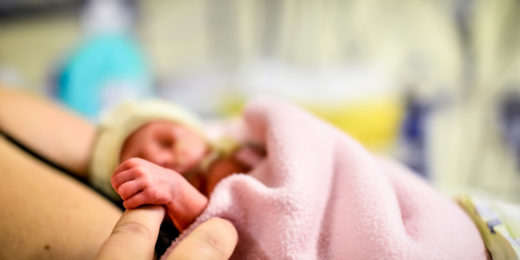California is doing a better job than most of the country at preventing the leading cause of childhood blindness, helping shrink racial disparities in the process, according to a new Stanford Medicine-led study.
The vision-damaging disease, called retinopathy of prematurity, is one of the top complications of premature birth. Across the United States, rates of this eye disease have nearly doubled in the last 20 years. But, thanks to meticulous efforts to care for premature newborns at hospitals throughout California, the golden state is bucking that trend. The findings were reported recently in JAMA Ophthalmology.
"Because California has been going in a different direction, there is potential to learn lessons here that can be used in the rest of the country," said the study's lead author, MK Quinn, PhD, a postdoctoral scholar in neonatal and developmental medicine.
Because California has been going in a different direction, there is potential to learn lessons here that can be used in the rest of the country.
MK Quinn
Babies born at least three weeks before their due dates are considered premature. Retinopathy happens mostly in those born even earlier; the study focused on rates of the condition in newborns who arrived at least eight weeks early.
Not only have California's retinopathy rates held steady, but the gap in disease rates between babies of different racial and ethnic backgrounds in California has shrunk, with the biggest declines in retinopathy among Hispanic and Asian infants, the study found.
"We're decreasing racial disparities," said study co-author Jochen Profit, MD, the Wendy J. Tomlin-Hess Endowed Professor, co-chair of the California Perinatal Quality Care Collaborative and a professor of neonatal medicine. Quinn and Profit collaborated with scientists at the University of California, San Diego and UCLA on the research.
Although doctors can't stop every case of retinopathy, which happens when abnormal blood vessel growth in preemies' eyes damages their vision, better medical care prevents some cases, he noted. And by checking preemies' eyes at the right time, physicians can find cases early, when there is an opportunity to keep the disease from worsening.
"Screening for this disease requires its own system in neonatal intensive care units, where people are really dedicated to making sure that no baby is missed," Profit said. In the past, preemies from minority groups were less likely to get their eyes checked at the right time. Making sure all of them receive an eye exam has helped close the disparities, he explained.
There are a lot of ways you can approach health equity. But quality improvement and limiting variability in care lift all boats.
Jochen Profit
"There are a lot of ways you can approach health equity," Profit said. "But quality improvement and limiting variability in care lift all boats."
The blood vessel challenge
Because they're born early, preemies' eyes aren't fully developed. They still need to grow blood vessels throughout the retina, the light-sensing layer at the back of the eye. The retina receives light through the pupil and sends signals to the brain that get turned into the images we see.
"For blood vessel growth to happen normally, you must limit noxious stimulants which can derail the process," Profit said. Abnormal blood vessels can bleed into the eye and cause the retina to detach from the back of the eye, which causes blindness.

The challenge is that blood vessel growth can be derailed by something else preemies need: oxygen. Preemies have immature lungs and may require a ventilator to help them breathe. But on a ventilator, they sometimes get too much oxygen, or experience big swings in oxygen levels. Both situations can stimulate abnormal blood vessel growth in the eyes.
Experts across California have been learning how to support preemies' breathing with less risk to their eyes. They have instituted oxygen management practices statewide, such as figuring out soon after birth which babies can receive breathing assistance from a device known as continuous positive airway pressure (CPAP) instead of a ventilator. With CPAP, it can be easier to prevent fluctuations in oxygen levels. For tiny patients who do require a ventilator, medical teams are also working hard to provide just the right amount of oxygen, not too little and not too much, following what they call the "Goldilocks rule of neonatology."
In addition, doctors are checking infants for early signs of retinopathy. Every baby at risk needs to be screened, usually around four weeks of age, depending on how early they were born. In severe cases, doctors can sometimes surgically reattach a detached retina, but at that stage, most infants will not recover vision, so the aim is to find cases before detachment occurs.
If they find problems early on, doctors can give a drug that slows blood vessel growth. The drug hinders a natural growth factor in the blood vessel walls. If a baby has early signs of retinopathy, the drug can be given directly into the eye to moderate blood vessel growth there without affecting other parts of the body. In some cases, if that is not successful, they can use laser therapy or cryotherapy, although these options risk damaging babies' peripheral vision.
Steady screening, better outcomes
The study included more than 48,000 infants born in California between 2012 and 2021 who arrived at least eight weeks premature or were very small, weighing less than 3.3 pounds at birth. The babies were hospitalized in neonatal intensive care units.
The researchers found that hospitals were doing a good job of looking for retinopathy: 95% to 98% of babies who needed screening had their eyes checked throughout the period studied. Screening rates were equally high in California newborns of all races.
The overall rate of retinopathy declined slightly throughout the study period. The change was driven by reductions in retinopathy in Hispanic and Asian babies, who had the highest retinopathy rates at the beginning of the study. Rates in other groups remained steady.
More on pediatric care
- Skin-to-skin 'kangaroo care' found to boost neurodevelopment in preemies
- Moms' and babies' medical data predicts prematurity complications, Stanford Medicine-led study shows
- Wearable device data reveals that reduced sleep and activity in pregnancy is linked to premature birth risk
"We weren't expecting the decreasing racial and ethnic disparities," Quinn said. "That's what we were most surprised by."
The researchers also investigated the treatments used to address retinopathy and found that doctors increasingly utilized the growth factor-inhibiting drug, with a 14% average increase in its use per year -- a good sign as it preserves more vision than other treatment options.
"As they grow up, it's common for preemies to have nearsightedness or astigmatism, mild to moderate vision problems," Profit said. They can usually be helped with glasses, and those kids can lead normal lives, he noted, adding, "What we're really trying to prevent is blindness or near blindness. Hopefully in the future, we will learn how to prevent the other visual impairments."
"Many people across the state have been trying to improve this," Quinn said. "All those little steps took years before the payoff, but now we're seeing some great results."
Image: peterbako/Shutterstock.com






